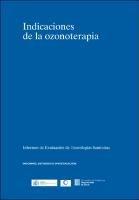| dc.contributor | Departament de Salut |
| dc.contributor.author | Trujillo-Alemán, Sara |
| dc.contributor.author | Almazán, Cari |
| dc.date.accessioned | 2017-09-20T11:36:23Z |
| dc.date.available | 2017-09-20T11:36:23Z |
| dc.date.issued | 2014 |
| dc.identifier.citation | Trujillo-Alemán S, Almazán C. Indicaciones de la ozonoterapia. Barcelona: Agència de Qualitat i Avaluació Sanitàries de Catalunya; 2014. |
| dc.identifier.uri | https://hdl.handle.net/11351/3065 |
| dc.description | Ozone therapy; Musculoskeletal system; Treatment |
| dc.description.abstract | Objetive: Analyse and synthesise scientific evidence concerning the efficiency and safety of ozone therapy in the treatment of musculoskeletal diseases.
Methodology: A systematic review was carried out of the scientific evidence (RSEC) in the principal bibliography reference databases (MEDLINE, SCOPUS, ISI Web of Knowledge, OVID EMB and UK CRD Databases) between 2006 and March 2013, to pinpoint clinical practice guidelines (GCP), RSEC, metaanalysis and experimental studies with a comparison group (clinical studies, random or not). The study population was defined as patients over 18 diagnosed with some type of musculoskeletal disease. The use of ozone separately was compared to its use in combination with a placebo or other intervention.
The general results’ variables were the morphological changes, changes in the principal symptoms and signs of the pathology in question,changes in functionality, changes in quality of life, patient satisfaction and adverse side effects. The Assessment of the methodological quality of the publications identified was performed according to Scottish Intercollegiate Guidelines Network (SIGN) criterion and levels of evidence. The data collected was synthesised in a narrative fashion and presented in evidence tables.
Results: 24 publications were chosen, 3 of which evaluated the efficiency/effectiveness of ozone therapy (1 meta-analysis and 2 experimental studies with a control group), 6 of which evaluated the efficiency/effectiveness and safety in a joint manner (1 meta-analysis and 5 experimental studies with a comparison group) and 15 studies referenced safety (15 case series). The methodological
quality of the majority of the studies was considered to be low. The vast majority of the studies included to assess the efficiency/effectiveness of ozone therapy analysed patients diagnosed with disk herniation; In general, this therapy presents better results than control treatments such as steroid injections, non-steroidal anti-inflammatory injections or conservative treatment with analgesics and partial rest; but this is not the case when compared with discectomy. Specifically, improvements attributed to ozone therapy are based primarily on pain relief and an improvement in functional disability. The treatment which appears to produce the best results involves a combination of intradiscal O2-O3 injections and radiofrequency treatment in patients with acute radicular pain with imaging test evidence of disk herniation. For the evaluation of the safety of ozone therapy, studies were also obtained involving other musculoskeletal diseases, besides disk herniation. No extremely serious complications were observed. The most commonly reported side effect is transient headache, followed by pain at the puncture site.
Conclusions: Ozone therapy combined with radiofrequency treatment appears to be effective in patients with secondary back pain to disk herniation, resulting in an improvement in levels of pain and functional disability. The complications and adverse side effects described are, in general, mild and transitory. In spite of the results outlined in the studies reviewed, the scientific evidence
available to date is insufficient and of a low methodological quality in that it fails to demonstrate the effectiveness of ozone therapy in the treatment of disk herniation, in particular, and of other musculoskeletal diseases, in general. |
| dc.language.iso | spa |
| dc.publisher | Agència de Qualitat i Avaluació Sanitàries de Catalunya |
| dc.publisher | Ministerio de Sanidad, Servicios Sociales e Igualdad |
| dc.relation.ispartofseries | Informes de Evaluación de Tecnologías Sanitarias; |
| dc.relation.ispartofseries | Informes, estudios e investigación; |
| dc.rights | Atribución-NoComercial-SinDerivadas 3.0 España |
| dc.rights.uri | http://creativecommons.org/licenses/by-nc-nd/3.0/es/ |
| dc.source | Scientia |
| dc.subject | Aparell locomotor - Malalties - Tractament |
| dc.subject | Ozó - Ús terapéutic |
| dc.subject.mesh | Ozone |
| dc.subject.mesh | /therapeutic use |
| dc.subject.mesh | Musculoskeletal System |
| dc.title | Indicaciones de la ozonoterapia |
| dc.type | info:eu-repo/semantics/report |
| dc.subject.decs | ozono |
| dc.subject.decs | /uso terapéutico |
| dc.subject.decs | sistema musculoesquelético |
| dc.type.version | info:eu-repo/semantics/publishedVersion |
| dc.audience | Professionals |
| dc.contributor.authoraffiliation | [Trujillo-Alemán, S] Unidad Docente de Medicina Preventiva y Salud Pública de Canarias, Dirección del Servicio Canario de la Salud (SCS), Las Palmas de Gran Canaria, Spain. [Almazán C] Agència de Qualitat i Avaluació Sanitàries de Catalunya (AQUAS), Departament de Salut, Generalitat de Catalunya, Barcelona, Spain |
| dc.rights.accessrights | info:eu-repo/semantics/openAccess |

